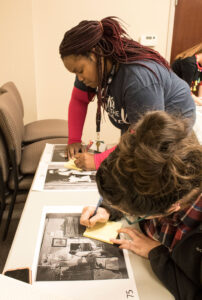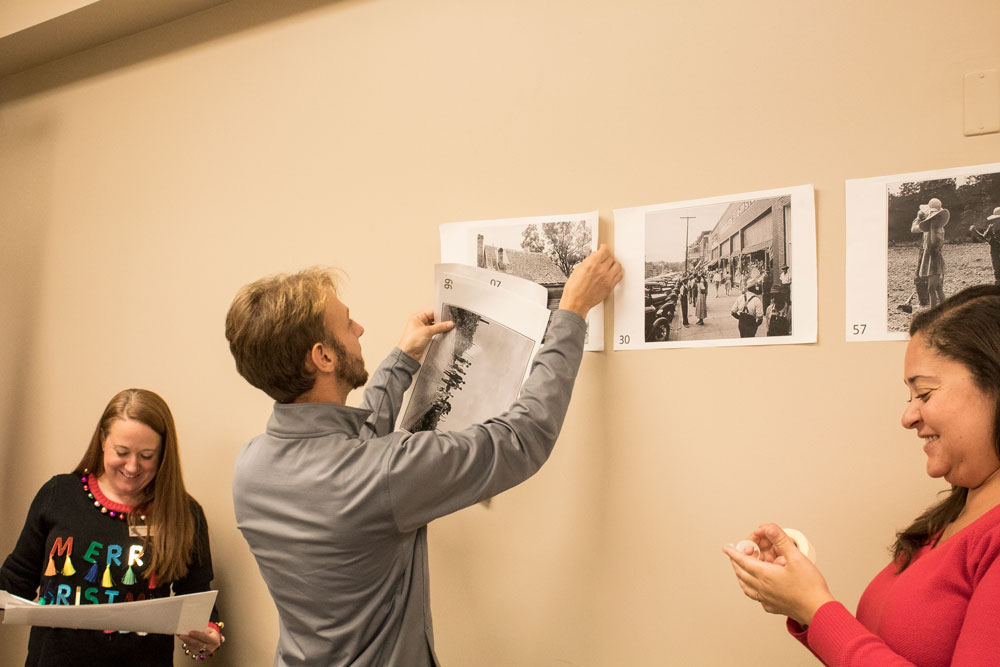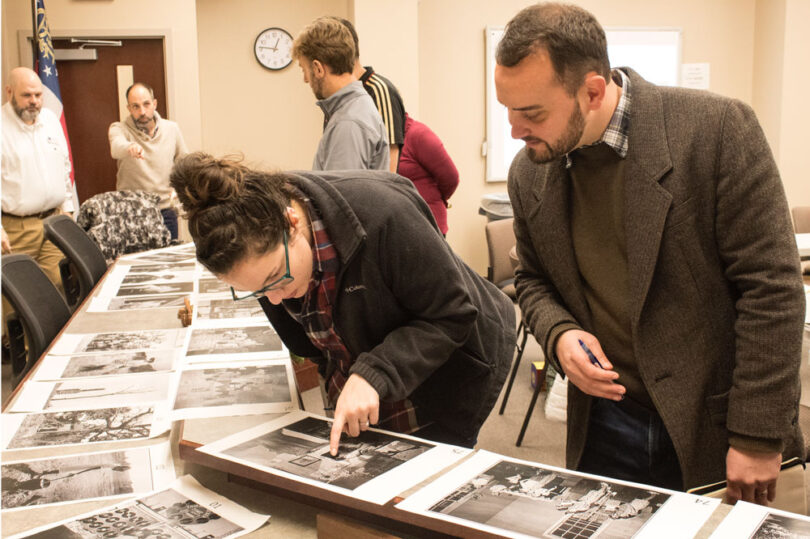This year, high school students in Putnam County are working with Atlanta playwright Natasha Patel to highlight what it’s like growing up in their community.
The scenes they’ve written draw on local historical artifacts, including photographs that capture the racial and economic realities of Putnam in the mid-20th century.

The photographs, stored in the National Archives, were taken in May 1941 as part of a Works Progress Administration effort to document American farmland. (Photo by Kristen Morales)
For some students, these photographs strike a familiar chord—the street corners where people once gathered nearly a century ago remain virtually unchanged today. For others, those images raise questions about the people in the photographs. What backstories did these people have? What challenges did they face? Were any students related to the people pictured?
By asking these questions, some students discovered new facts about their family lineages, but all of them gained a better understanding of the history of their community.
Teaching students to investigate their past is a key component of a years-long project between the Putnam County Charter School System (PCCSS) and the University of Georgia’s Mary Frances Early College of Education. For example, photographs housed in the U.S. National Archives and Records Administration have been used by Putnam teachers since 2018 to support rich community-based learning activities that span from elementary students to high school students.
“The goal of the Putnam Project is to pepper each of the grade levels with activities that are centered around introducing students to hyper-local history questions,” said Theodore Kopcha, associate professor in the department of career and information studies. “By the time students get to 12th grade, they’ve had multiple lessons with different teachers, all of them putting their own spin on this model and addressing the standards that they are responsible for in their own unique way.”
An expanding partnership
Thanks to a new research-practice partnership grant from the Spencer Foundation, PCCSS and Kopcha will expand their ongoing partnership by weaving it together with Albany State University, a historically Black university in Albany, Georgia.

(L to R) Candace Wooten, Andrew Grodecki and Whitney Priest attend a project-based learning workshop to help students align historical photographs with content standards for K-12 classrooms. (Photo by Kristen Morales)
Putnam and ASU have partnered for the past four years to develop first-generation-to-college students. This program not only brings ASU administrators and faculty into Putnam classrooms throughout the academic year, but also sends nearly 90 PCCSS students and up to 20 teachers to live and work on the ASU campus for a week each summer.
The grant will allow those involved in the project, including UGA alumnus Christopher Lawton, director of experiential learning of PCCSS, to more fully integrate these two aligned efforts to create a pipeline between PCCSS and ASU, while continuing to develop and shape the Putnam model as a pathway to student success.
“Putnam County Charter School System is committed to expanding the scope, reach and possibilities of public K-12 education to meet the unique needs of our students and others like them across rural Georgia,” said Lawton. “We are honored that the Spencer Foundation sees valuable innovation in the work we have done over these past years and is willing to invest in the future we hope to create. It is a testament to our trusted long-term partnerships with TJ Kopcha and UGA doctoral student Katie Walters, as well ASU dean Melanie Hatch and senior ASU faculty in the arts, biology, history, education and sociology. Each institution and team member brings unique tools and skills that make us exponentially stronger together.”
One of the primary goals of the Putnam model is to engage high school students across all grade levels with their local past by participating in community projects, which have included researching enslaved communities in the 19th century, re-photographing historical photos, conducting oral histories with older community members who lived through segregation and investigating the history of agriculture and its connections to modern plant biodiversity in the county. By participating in these activities, students develop critical thinking skills and feel empowered to chip away at generational rural poverty.
“A lot of times the dominant narrative doesn’t always match up with what students are actually experiencing,” said Kopcha. “When the roots of that narrative are left untouched—or when other perspectives on that narrative don’t come to the forefront—students are left feeling like there must be something wrong with them because they’re not experiencing what they think they’re supposed to be experiencing from their community. And so that’s really at the heart of the model.”
Measuring student success
The partnership between UGA, PCCSS and ASU aims to flip the paradigm that students need to succeed in college on their own without the support of their institution.
“Now that we have this direct connection with ASU, we’re asking how we can help students and understand what their expectations are coming in,” added Kopcha. “A common perspective of college is that you either sink or swim. And so, this is really trying to create a space where we’re going to work with each other to figure out what’s best for the student.”
For the project, Kopcha, along with doctoral student Katherine Walters, will continue supporting teachers in PCCSS by conducting professional development workshops with teachers and helping them create project-based learning activities that focus on integrating local history into classroom curricula across a variety of subject areas.
Additionally, Walters is developing a research structure that goes beyond assessing student performance on state standardized tests to gauge the long-term effects of the partnership.
“Our project has multiple layers to help students understand the past through local history in a way that helps them understand who they are while bridging the transition to adult life and the college experience,” said Walters. “We’re interested in students’ experiences with the curriculum and how it impacts the ways they see themselves and others in their communities. Who they are becoming throughout this experience is as important as their academic achievements.”
To better reflect the breadth of student success, the project will analyze other indicators of growth that can help as students transition into their post-secondary education, including student engagement, attitudes, sense of belonging and more.
“The question becomes, does a shared pedagogical approach give them an advantage so that the transition to college is easier compared to someone who might not get that experience?” said Kopcha. “Our vision for this project is to get this curriculum into multiple high schools and see how it can help ease the transition from high school to a place like ASU.”








